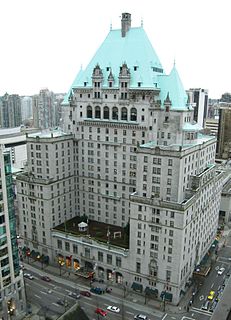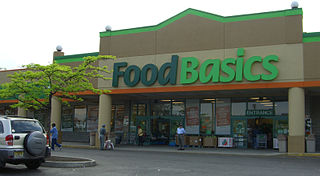The Atlantic Ocean is the second largest of the world's oceans, that separates the old world from the new world.

The Fairmont Hotel Vancouver, formerly and commonly referred to as the Hotel Vancouver, is a historic hotel in Vancouver, British Columbia. Located along West Georgia Street the hotel is situated within the city's Financial District, in Downtown Vancouver. The hotel was designed by two architects, John Smith Archibald, and John Schofield. The hotel is presently managed by Fairmont Hotels and Resorts.

George Huntington Hartford headed The Great Atlantic and Pacific Tea Company (A&P) from 1878 to 1917. During this period, A&P created the concept of the chain grocery store and expanded into the country's largest retailer. He joined the firm as a clerk in 1861 and quickly assumed managerial responsibilities. When A&P's founder, George Gilman, retired in 1878, Hartford entered into a partnership agreement and ran the company until the founder's death in 1901. In the settlement of Gilman's estate, Hartford acquired control of the company and ultimately purchased the interests of Gilman's heirs.
SuperFresh is a supermarket brand owned by Key Food Stores which operates in suburban areas of New York City and Northern New Jersey. The company currently operates ten supermarkets.

The Fairmont Empress, formerly and commonly referred to as The Empress, is one of the oldest hotels in Victoria, British Columbia, Canada. Located on 721 Government Street, it is situated in Downtown Victoria, facing the city's Inner Harbour. The hotel was designed by Francis Rattenbury, and was built by Canadian Pacific Hotels, a division of the Canadian Pacific Railway company. The hotel is presently managed by Fairmont Hotels and Resorts.

Food Basics was a no-frills discount supermarket chain owned and operated by The Great Atlantic & Pacific Tea Company in the northeastern United States.
George Ludlum Hartford was the longtime Chairman and Treasurer of the Great Atlantic and Pacific Tea Company (A&P), serving in those positions for over 40 years from 1916 until his death. He was the successor to his father, George Huntington Hartford (1832–1917) and lead the company with his younger brother, John Augustine Hartford (1872–1951). Under the terms of their father's will, the two brothers had total control of the company's voting stock as long as either was alive. "Mr. George" as he was known to distinguish him from his father, "Mr. Hartford", was considered the "financial genius" at the firm who balanced his brother, "Mr. John" who was the firm's "merchandising power". They built the chain into the world's largest retailer with annual sales of $4.5 billion in 1957 when George died. Time Magazine interviewed John and his brother George who were on their cover in November 1950. Wall Street Journal in an editorial on August 29, 2011 wrote "Together the brothers, neither of whom had finished high school, built what would be, for 40 years, the largest retail outlet in the world." The New York Times in an editorial on September 7, 2011 wrote that John and George Hartford "were among the 20th century’s most accomplished and visionary businessmen."
Georgia usually refers to:
Edward Vassallo Hartford was the founder and President of the Hartford Suspension Company who perfected the automobile shock absorber. The middle son of A&P owner George Huntington Hartford and Marie Josephine Ludlum, Edward was the only son not involved in day-to-day operations of the food chain. However, starting in 1903, he was Secretary of the A&P corporation and along with his brothers George and John, he was also one of the three trustees who controlled the company's stock after his father died.

The Powerhouse Arts District is a historic warehouse district in Downtown Jersey City, New Jersey, United States. Its name derives from the unused generating station Hudson and Manhattan Railroad Powerhouse. This neighborhood was previously called "WALDO", an acronym for Work And Live District Overlay, but has since been renamed though is still occasionally used on maps and in local parlance. Part of what was once called the Horseshoe Section, the neighborhood's informal borders are Newport to the north, Exchange Place to the east, Paulus Hook to the south and Harsimus Cove to the west.
The Twin Falls Tea House National Historic Site of Canada, located in Yoho National Park, British Columbia as a resting place for hikers and trail riders in the park. The rustic structure is located near Twin Falls in the Little Yoho Valley. The first phase of construction took place about 1908. A separate two-story cabin was built adjoining the original cabin about 1923, and the two structures were linked between 1925 and 1928. Proposed for demolition in 1969, the Tea House was designated a National Historic Site of Canada in 1992, and was extensively renovated in 2005.
The National Tea Company was a Midwestern United States grocery chain that operated during the 20th century.
A&P Family Mart, sometimes referred to simply as Family Mart or Family Mart Sav-A-Center, was a Clearwater, Florida-based chain of full-service supermarkets in the southern United States from the 1970s through the 1990s; it was part of The Great Atlantic & Pacific Tea Company (A&P) group of stores. The last Family Mart closed in 1999.
A-Mart was an American discount supermarket chain that operated in the Eastern United States from 1969, until all locations were renamed by its parent company, the Great Atlantic and Pacific Tea Company (A&P), to that name by 1972.
Warehouse Economy Outlet, (W.E.O), Where Economy Originates, was a discount, warehouse-style supermarket concept that was developed in the 1970s by The Great Atlantic & Pacific Tea Company (A&P), and is credited with being among the first of its kind in the industry. The first W.E.O. opened in Pennsauken, New Jersey in 1971, and quickly became a successful, profitable venture. W.E.O. featured top-selling grocery items in their original wholesale bulk packaging at greatly reduced prices. In 1972 A&P expanded this format to 1,500 stores; however, the expansion failed because many of its older stores, built prior to the 1950s, were not large enough to stock the large quantities of discounted groceries that the format called for. By 1975, A&P abandoned the format.

The Great Atlantic and Pacific Tea Company (A&P) Warehouse, located at 67 Vestry Street, is a historic building in the Tribeca section of Lower Manhattan in New York City. Originally a storage building, it was later converted to residential use and has since been historically linked to the New York City arts scene.

The Great Atlantic and Pacific Tea Company Warehouse, also known as the A&P Warehouse and The Keystone Warehouse Company, is a historic warehouse building located in Buffalo, Erie County, New York. It was built in 1917, is an eight-story reinforced concrete industrial building encompassing 250,000 square feet of warehouse space. It has a one-story wing built of concrete block walls and steel framing. The building was occupied by The Great Atlantic & Pacific Tea Company until 1975.










